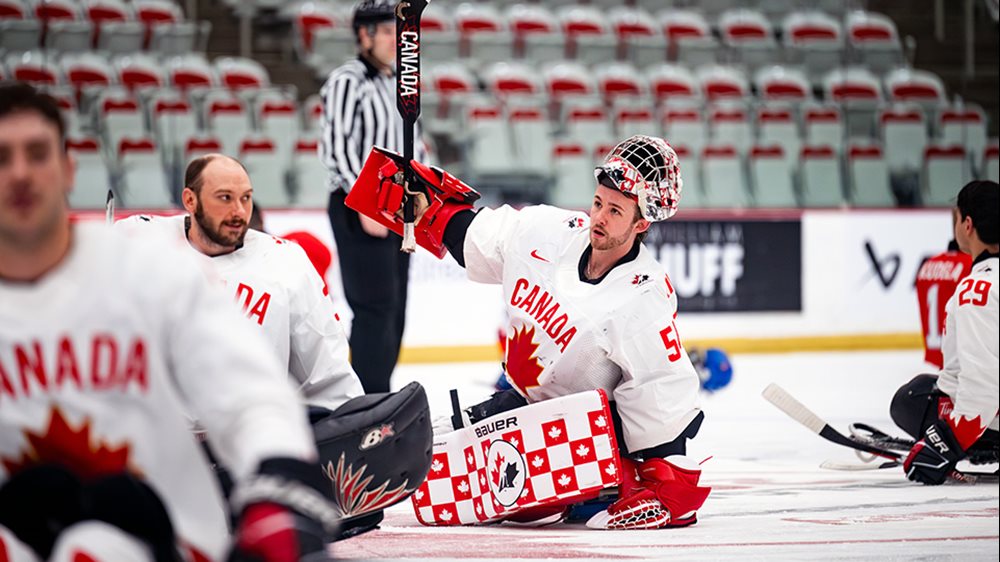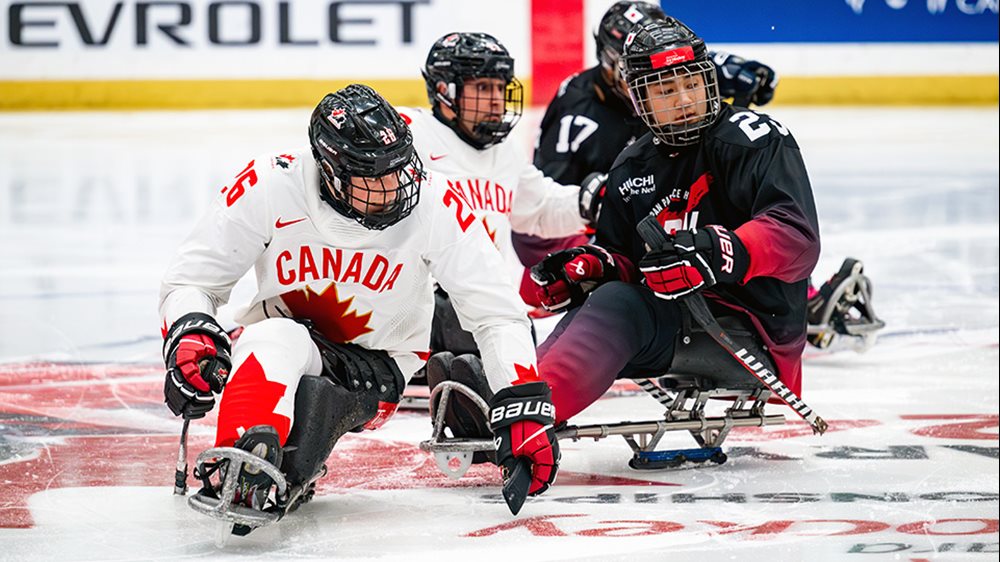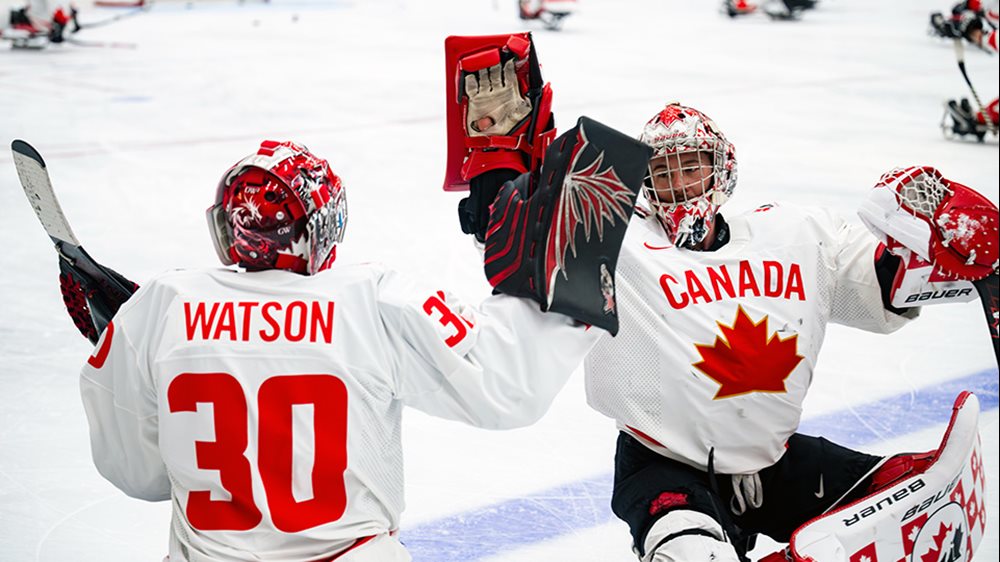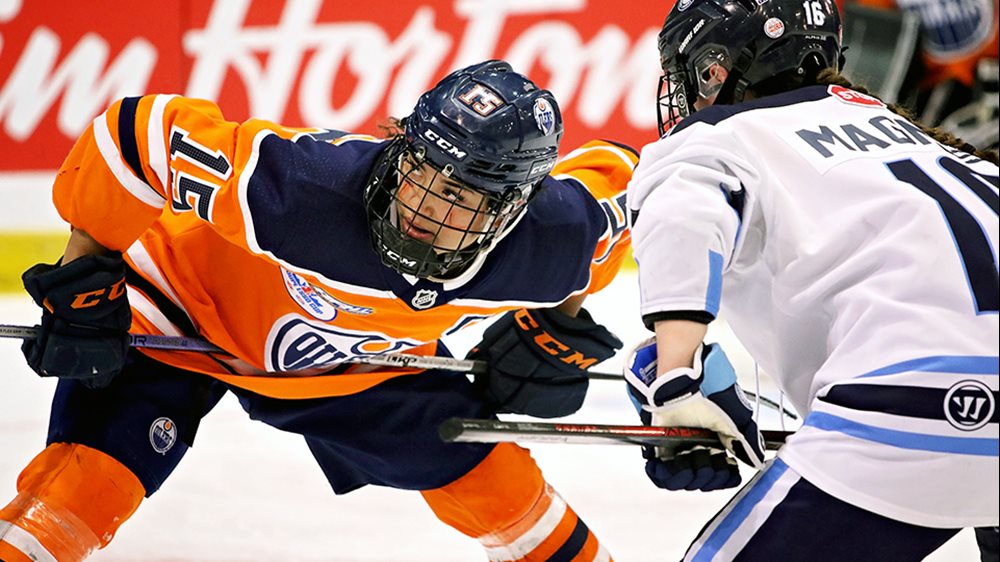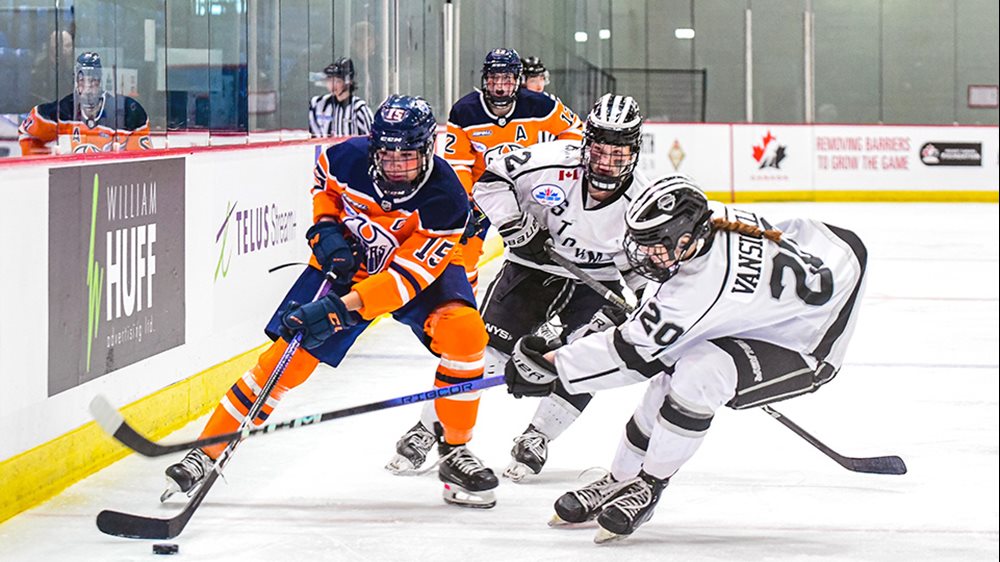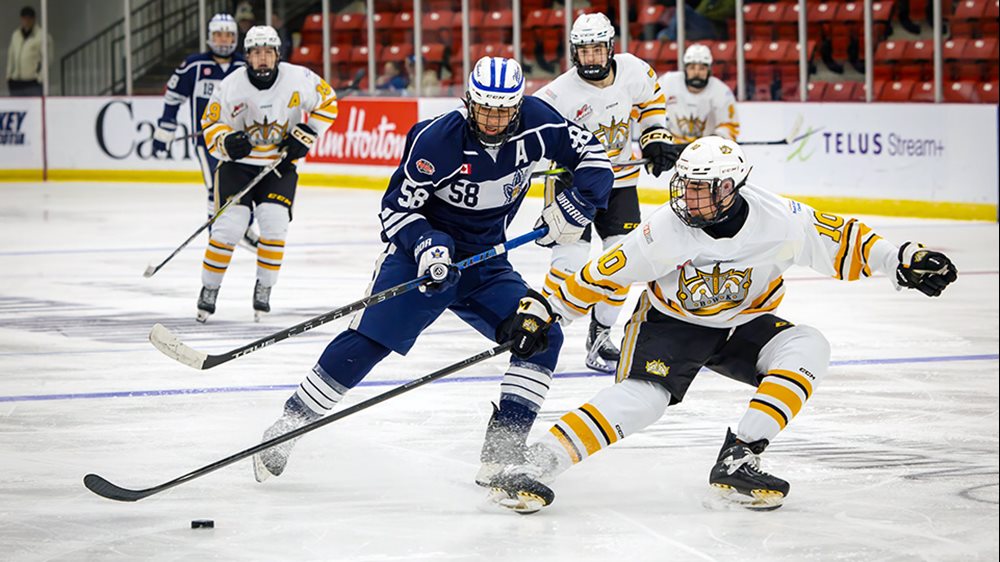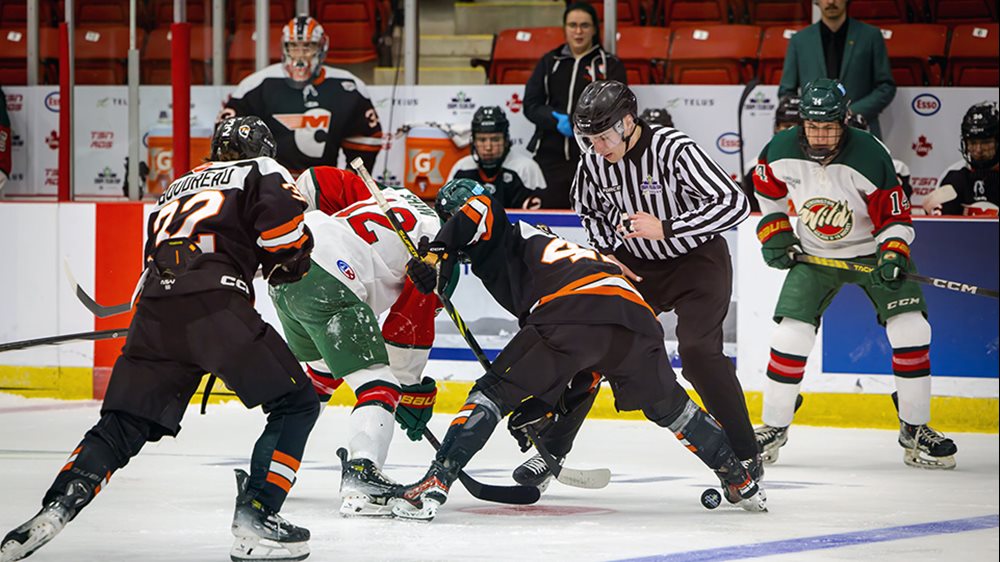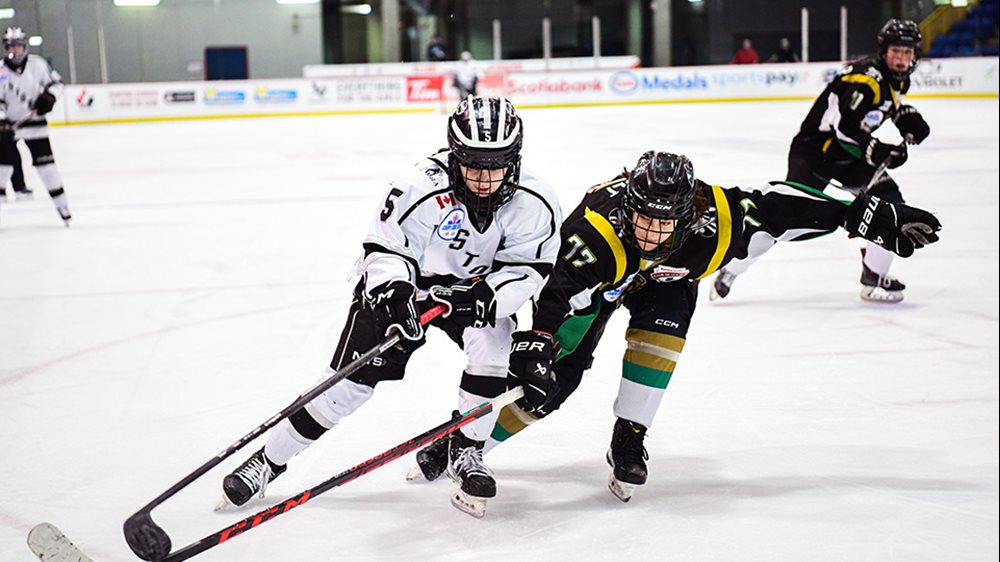
Power skills, power people
A hockey camp created by Wacey Rabbit and supported by the Indigenous Sport Council of Alberta is giving Indigenous kids a place to be kids
Hockey and community have always gone hand-in-hand for Wacey Rabbit. He remembers getting to the rink for one of his first practices was a family effort.
“My mom didn’t know how to put on my equipment, and I had a 6 a.m. practice, so we had to drive 20 minutes to my grandparents’ place,” Rabbit laughs. “So, I’m sitting there watching Saturday morning cartoons and eating my cereal while my grandparents are showing my mom how to put my equipment on.”
Those memories full of family and friends are the foundation on which Rabbit’s love for the game was built. The 34-year-old just finished his 15th season as a professional, the last three-and-a-half with the Jacksonville Icemen in the ECHL. But his experiences within the game didn’t always match his positive outlook. Rabbit remembers the first time he was exposed to racist and derogatory comments at the rink as a 10-year-old playing in his first major tournament away from the Kainai First Nation in southern Alberta.
“I remember talking to my parents and grandparents about it and my grandma said, ‘It’s not a reflection on you, it’s a reflection on them for what they’re saying. You be proud of who you are, and you be proud of where I come from.’ And I’ve taken those words with me everywhere I go,” Rabbit says.
“I’m a very proud First Nations man. I come from the Blood Tribe, I’m Blackfoot. For me to say those things and recognize those things, I hope that the next generation is proud that they can chase their dreams whether it’s on reserve or off reserve, whether it’s in academics, sports, whatever it is, whatever their passion is, that they believe in themselves to go and chase that.”
Rabbit is trying to support at least some of the dreams of Indigenous youth, by creating the WR20 Power Skill Hockey Camp and touring it around Alberta. (He has plans to take his camps to First Nations throughout the country when it is safe to do so.)
“We’re just trying to get the game out there and the wellness of sports and living healthy,” Rabbit explains. “Especially with COVID, you could see how hard it was on some of the younger kids … it was important that, even if it was just for an hour a day, these kids got to go on the ice and just be kids to help with their mental health.”
While some locations had to be moved or ice times adjusted to meet public health protocols, Rabbit managed to host camps in Kainai, Siksika and Frog Lake First Nations. At each stop, he recruited other Indigenous professional players to help, including Devin Buffalo.
“Just seeing him work with the kids in Frog Lake, you could tell, a lot of coaches don’t have that connection with the youth,” Buffalo says. “I was able to learn from him, to remember that for the youth, hockey is fun and to keep it fun not to make it too serious, and sometimes it is OK to make hockey playful and play games and just keep things light and fun.”
Captain Indigenous from Frog Lake First Nation WR20 Power Skill Youth Hockey Camp. Day 2 let’s roll ! pic.twitter.com/AE23yROvNf
— Wacey Rabbit (@WaceyRabbit20) October 31, 2020
Growing up, Buffalo says he knew Rabbit had a very successful junior career in the Western Hockey League (including a Memorial Cup in 2007 with the Vancouver Giants) and had gone on to play professionally, but didn’t really get to know him personally until they were both in the ECHL. With similar experiences in their past, Buffalo says Rabbit naturally became a mentor for him and has been a huge support in his own post-playing career, creating goalie camps focused on the development of Indigenous netminders.
“ [Now I’m] passing that on, creating players that are not just great hockey players but great people and students in the classroom,” says Buffalo, who earned a political science degree at Dartmouth College while playing for its men’s hockey team.
In addition to running his own camps, Buffalo works with the Indigenous Sport Council of Alberta. He says it was a great decision by the executive committee to name Rabbit a hockey ambassador for the Council.
“He was definitely someone who had all the attributes we were looking for in an ambassador and just the way he responds to the kids and all the kids he does work with have glowing reviews, so I think it was an easy decision,” Buffalo explains.
“Hockey is my passion, but my people are the most important thing for me – my family,” Rabbit says. “Hopefully in 10 years there’s a hundred kids in the NHL and we see a First Nations kid playing for the (Maple) Leafs, finally giving them their [Stanley] Cup, but he’s the captain raising the banner; that’s what I want for the next generation.”
Rabbit laughs while making the joke about the 54-year drought for the Leafs, but keeps smiling thinking about the possibilities for his people.
“For our next generation, I just want to make sure it’s an easier transition for them to get into sports, because at the end of the day sports is about community. It’s about coming together; it’s about having fun … so it’s about building community in sports. I think that’s the most important part.
“Everybody has a voice; everybody has a right to go play and feel like they’re accepted.”
More information on WR20 Power Skill Youth Hockey Camps can be found by following Wacey Rabbit on Instagram @wr20powerskills , and check out WaniskaMentality.com for more information about Devin Buffalo’s goaltender camps.

The importance of orange
The Orange Jersey Project is using the power of sport to educate young players about residential schools and strengthen the path towards truth and reconciliation
While Canada today recognizes the third annual National Day for Truth and Reconciliation to honour the children, survivors, families and communities affected by residential schools, the day has long held significant meaning for the Indigenous community.
Since 2013, Sept. 30 has been Orange Shirt Day, which was started by residential school survivor Phyllis Webstad. She wore an orange shirt on her first day at the St. Joseph’s Mission Residential School in the fall of 1973, which was taken from her by staff.
“The color orange has always reminded me of … how my feelings didn’t matter, how no one cared and how I felt like I was worth nothing. All of us little children were crying and no one cared,” Webstad shared at OrangeShirtDay.org.
Webstad launched the Orange Shirt Society “to be able to tell my story so that others may benefit and understand, and maybe other survivors will feel comfortable enough to share their stories.”
Last year, the Orange Shirt Society expended into the sporting community with the creation of the Orange Jersey Project, with Webstad’s son, Jeremy Boston, serving as project manager. According to the website, the project was born out of an idea – “What if we could use the power of sport to serve as a vehicle toward educating today’s young athletes about the history of the Indian Residential School System and strengthen the path toward truth and reconciliation with Indigenous Peoples.”
As part of that education, each jersey features a QR code that links to an online platform that will help children discover the history of residential schools, with the goal to encourage learning, engagement, sharing and activities.
The project began with hockey jerseys during the 2021-22 season, more than 20,000 of which have been distributed to hundreds of teams from coast to coast to coast over the last two seasons.
Last season, the Orange Jersey Project partnered with the Western Hockey League (WHL), with all teams wearing a special WHL Truth and Reconciliation logo in early October 2022. (Teams will do so again this season, beginning today.) In addition, 11 teams wore special-edition orange jerseys during warmups prior to games in February 2023, which were later auctioned off.
At the conclusion of the campaign, $22,500 was donated to the Orange Jersey Project, funds that will go towards providing more minor hockey teams with their own orange jerseys.
On the National Day for Truth and Reconciliation, HockeyCanada.ca caught up with Boston to discuss the Orange Jersey Project, continuing his mother’s passion project and what the future holds.
Where did the idea for the Orange Jersey Project come from?
The Orange Jersey Project was created by Tyler Fuller, an Indigenous male from Kawacatoose First Nation in Saskatchewan who played pro hockey in the Central Hockey League (CHL) and International Hockey League (IHL). The idea of the Orange Jersey Project was born from an idea that came while Tyler and his wife Amanda were watching the news when the remains of the 215 children who were students of the Kamloops Indian Residential School in Tk’emlúps te Secwépemc were uncovered.
Tyler and Amanda came up with the idea to design a hockey jersey as a way to inform people about residential school survivors and victims. Tyler contacted Chief Willie Sellars of Williams Lake First Nation and asked for his guidance. Chief Sellars directed Tyler to Phyllis Webstad, the founder of the Orange Shirt Society, who introduced Tyler to the OSS executive director, who helped get the ball rolling.
Why was it important for the Orange Shirt Society to expend into sports?
Sports, such as hockey, are a great vessel for all Indigenous and non-Indigenous to come together to learn the real history of Canada. The Orange Shirt Society is designed to encourage action for truth and reconciliation and can help educate athletes about the history of the residential school system in Canada. The Orange Shirt Society works to create awareness of the intergenerational impacts of residential schools and the concept of Every Child Matters.
Why is this project important to your family and to the Indigenous community?
Four generations of my family have attended residential schools. My great-grandmother Lena Jack, my grandmother Rose Wilson and my mother Phyllis Webstad attended residential schools. I attended the last operational school in Canada in 1996. It is important for the path of healing and new beginnings in a Canada we all love. To overcome barriers between Indigenous and non-Indigenous to become one and come together as we continue to educate and learn together on our path for truth and reconciliation.
How can interested teams get their orange jerseys?
Beginning today, teams can visit OrangeJerseyProject.ca to register and request orange practice jerseys, as well as the curriculum program, at no cost, while supplies last.
Once teams have received their jerseys, they’re encouraged to choose several practices throughout the season dedicated to wearing the jerseys and spending a few minutes acknowledging the Treaty Lands upon which they are playing and the Indigenous Peoples who reside there. We also invite teams to participate in team-building activities off the ice to work through the curriculum together.
Hockey was first … which sports are next?
Currently our main focus is hockey, but we are planning to expand into other sports beginning sometime in 2024.
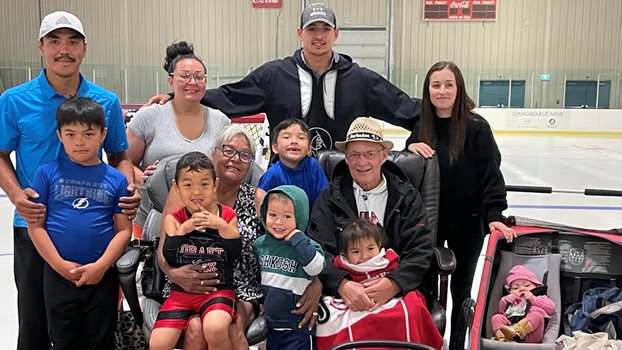
Leaving a lasting impression in the North
Tommy Williams left behind an impact on the Northwest Territories through his love for his family, the game of hockey, his Métis heritage and trying to make a difference for Indigenous youth
Tommy Williams was a man of the people in the Northwest Territories. Not only in his various roles throughout a long career in government, but also at the hockey rink.
“He was an amazing man … so passionate about the game and he really put his heart into hockey,” says Pamela Williams, Tommy’s wife of 32 years. “He cared so much about people, and he wanted to teach every kid the love he shared for the game and the joy of the sport.”
Williams died last August at 60 years old, after a battle with cancer. He left an impact on the community through his love for his family, the game of hockey, his Métis heritage and trying to make a difference for Northern youth.
He was a goaltender for 48 years, playing until he no longer physically could, even after getting knee and hip replacements.
His daughter Aurora always remembers him being involved in hockey from an early age.
“He coached me throughout my childhood, and he was always a favourite coach for the players,” she says. “He was a fun guy and made friends everywhere around the rink. Everyone respected him and he had a big impact on all of us.”
His passion for hockey was obvious to his family, including Pamela. Being at the rink is what made Tommy happy – it didn’t matter if he was playing, coaching or just watching games.
“He wanted to be a professional hockey player and he would always spend any free time at the rink,” Pamela says. “He played in rec leagues and old-timer leagues and would watch his kids and grandkids play at home and away at tournaments in different cities.”
Tommy played at different levels, reaching the Western Hockey League with the Medicine Hat Tigers as the back-up to former NHLer Kelly Hrudey. He enjoyed his time, but always felt pulled to the North and how he could grow the game and support Indigenous Peoples in his own community.

“He played such an important role model for so many Indigenous youth. He was proud of who he was, and he could connect and understand what those kids were going through,” says Aurora. “The kids he coached over the years still share how much of an impact he had on them.”
James easily fell into his dad’s footsteps with an early love for the game. He was coached from a young age by his dad, and he learned a lot about the game – on and off the ice – from him and used those lessons as he continued his playing career.
James left home at age 14 to play Junior A hockey in Summerside, P.E.I., with the Summerside Western Capitals of the Maritime Hockey League. He played a couple years of university hockey as well before returning home for good, but continued to play in the same recreational leagues his dad used to play in.
“He always wanted what was best for me and my sister,” James says. “When I moved away and felt homesick, he pushed me to do my best and he believed in me. Now that I’m back in Inuvik, I play in the same leagues he used to, and people still know who he was and what he meant to the hockey community.”
Like his dad, James had the opportunity to coach Team NWT at the Canada Winter Games in 2023, something his dad did in 2007.
Tommy was a person that easily made connections with people, particularly through the national game. One year, when no one stepped up to coach a U18 team, Tommy agreed to take the reins.
“This is one of my favourite stories about my dad,” James says. “He did what no one else wanted to do and those kids grew up to be leaders in their communities. He was proud to be Indigenous and he wanted to provide opportunities for others in the North.”
When Tommy died, those players shared with the Williams family how he helped them off the ice as much as he did on it.
The impact Tommy left on the community is vast. On top of being the president and CEO of the Northwest Territories Housing Corporation, he also opened a sports equipment store in Inuvik so more Indigenous youth could get involved in hockey. He never believed that just because a family couldn’t afford to play shouldn’t mean they couldn’t play, and helped create a fund to help cover fees for players.
“He just wanted kids from the North to have the same advantage as the kids in the south,” says James. “He was a public servant by trade, and he understood that role, but he also understood the need to give back through sports.”
Before he died, the community honoured Tommy for his contributions to the game by retiring his Mad Trappers jersey at the Ed Jeske Olympic Arena in town, a moment that meant a lot to the Williams family.
“He was so honoured and emotional to see that recognition,” Aurora says. “I still get emotional when I go to the rink and see his jersey. We are all so proud to see that recognition.”
Hockey will always be a part of their lives as James, Aurora and her husband Bryon all play in the rec leagues in Inuvik, and four of Aurora’s children play. Knowing how much Tommy loved the game, they want to continue to carry his legacy for their kids, but also youth in their communities.
“He was a wonderful man that shared his passion of hockey with everyone,” Pamela says. “He was taken way too soon, but we had a good life.”
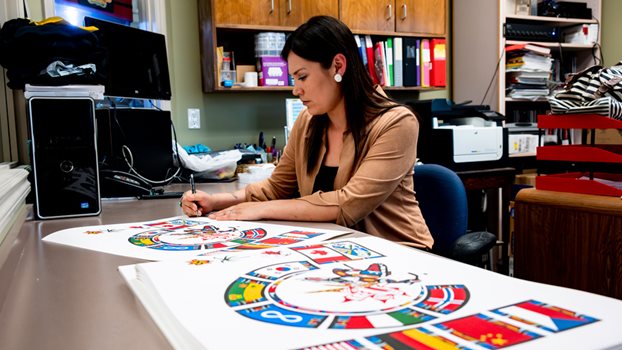
Celebrating unity with Indigenous art
The Player of the Game award for the 2023 World Para Hockey Championship is a limited-edition piece of artwork created by local Indigenous artists
A representation of unity will be front and centre during the 2023 World Para Hockey Championship thanks to a collaboration between two local Indigenous artists.
Brandy Jones is an Inuit artist who moved to Regina from British Columbia when she was 12 years old. Her work involves mixed mediums of native arts, representing unity among all Indigenous peoples. Rodger W. Ross is of Métis/Cree descent and a member of the George Gordon First Nation in Saskatchewan. He is a multi-disciplined artist and an international award-winning documentary film producer, whose career spans four decades.
Read on to learn more about Player of the Game artwork. Answers have been slightly edited for clarity and length.
Hockey Canada (HC): How did this collaboration come together for the 2023 World Para Hockey Championship?
Rodger Ross (RR): I've worked with the Moose Jaw Warriors in the past. I did a cultural presentation to them first, and then I created an orange shirt design for them. When the situation came up with the World Para Hockey Championship, one of the ladies that I worked with reached out and gave my information. […] Seeing how Brandy’s [art form] works so well for these forms, it just seemed like a perfect collaboration. So, when I was asked [who I would recommend], she was the first name [I suggested].
Brandy Jones (BJ): Rodger has always been a very big
support of my work. Not just on giving me advice, but sometimes when it
comes to collaboration with the work as well, there's things that he sees in
my work as I'm going along. He has a very good eye for it. For example, in
the hockey helmet, at first it was connected to the feather that was
attached there. And he was like, “You should put a white line to separate
that.” That's something that I hadn't even seen yet. I'm always willing to
work with Rodger because he always has the coolest jobs… I'm always very
happy to oblige.
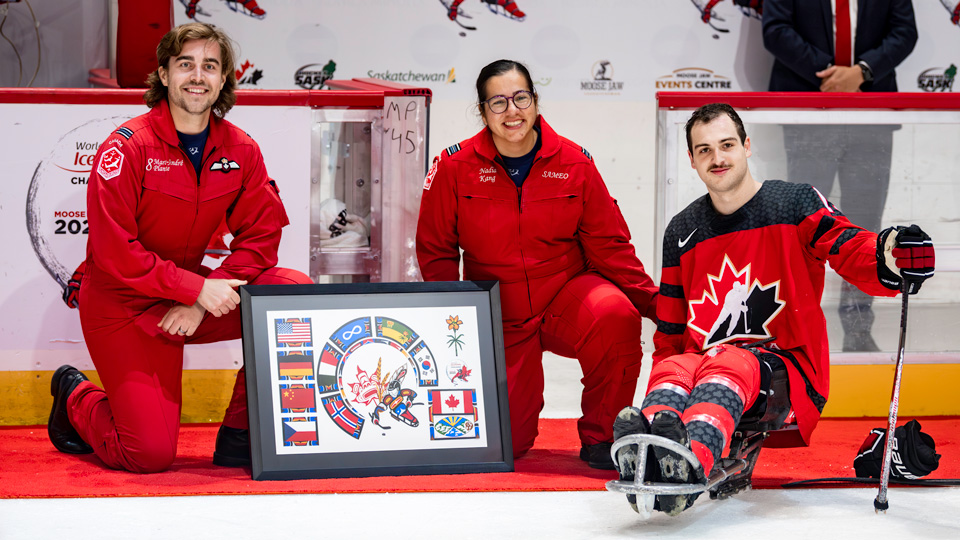 Captain Marc-André Plante and squadron aircraft maintenance engineering officer Nadia Kang of the Canadian Forces Snowbirds present Dominic Cozzolino with the player of the game award on May 29, 2023.
Captain Marc-André Plante and squadron aircraft maintenance engineering officer Nadia Kang of the Canadian Forces Snowbirds present Dominic Cozzolino with the player of the game award on May 29, 2023.
HC: What is the inspiration behind the design of the Player of the Game artwork?
RR: When we first got approached, I wanted to know more about the game because I haven't watched a lot of [para hockey]. But I've watched some para hockey, and I'm so impressed by it, because I'm a former hockey player as well. […] When I'm watching these players and how they move, the power that they have and that constant flow of energy, that to me had to be the centerpiece. […] The first thing I wanted was that hockey player in the middle, and I wanted that movement because Brandy’s art form works with that movement so well. And then I thought the best way to have the country's representatives is through their flags. […] Having the Métis flag, the Saskatchewan flag, the Treaty 4 flag, obviously the Canada flag is represented in the logo itself—to me, those seemed like the natural elements.
BJ: I think it's perfect the way that it came out. It’s the design for me that just feels like it represents Canada.
HC: Brandy, you also created another artwork for event stakeholders. What was the inspiration behind that piece?
BJ: It's a Thunderbird. Sometimes it's hard for people to decipher that type of work. Some people see it right away, and then other times people are looking in there thinking, “What is that?” That is something that Rodger and I had discussed. We had looked at the Four Directions and what represented each of those directions. For me, I really tried hard to mix those animals together. But I was finding that very hard to do at the time. I tried to just look at what I thought was the most powerful out of all four of those. I did add a bear in there as well, within the body. But for some reason, it was the Thunderbird that really stuck out to me, because there are bringers of the thunder. It’s kind of as simple as that it, it was the animal that I thought was the most powerful and stood out the most to represent what we were doing at the time.
HC: This is the first time the World Para Hockey Championship has been hosted in Canada. How does it feel knowing your contribution will be associated with the legacy of the event?
BJ: That’s so hard to answer because it just feels really incredible. There's no other way to describe it other than that; it's beautiful being able to represent like my country and also the province that I live in. It was definitely a labour of love, and I could not be happier.
RR: For me, it's always about relationships, and as far as Indigenous inclusion, any time that that I get invited to allow our voices to be heard, to allow our people to be represented, it's always going to be a great honour. But I also look at it as an obligation to reconciliation. […] It makes me feel very, very proud to be able to participate at this level, to be in an international event, and to be a part of that. For Brandy and I to be invited to hand out that award between the United States and Canada, with the world watching, I think is a pretty powerful statement of, “We haven't gone anywhere, and we're not going anywhere,” We're here, and we have beautiful cultures among us. It’s time that our voices be heard.
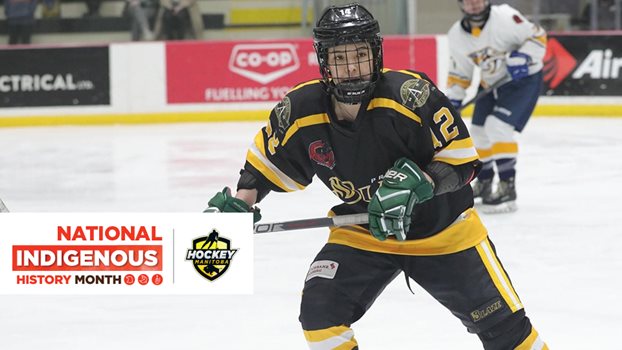
Finding new ways to win
Ready for the next step in her hockey journey, Keyanna Lea is embracing being behind the bench and serving as a role model for young Indigenous players
Keyanna Lea has been doing a lot of winning lately, both on the ice and behind the bench.
The 21-year-old from Berens River First Nation won the Manitoba Women’s Junior Hockey League (MWJHL) championship with the Prairie Blaze this past April and was named playoff MVP after registering 13 points (7-6—13) in eight playoff games.
Just over a month later, Lea was an assistant coach with Team Manitoba as it took home a gold medal at the 2022 National Aboriginal Hockey Championships (NAHC) in Membertou, Nova Scotia. It was Lea’s first time coaching the provincial team after winning back-to-back gold medals as a player in 2017 and 2018.
“It was definitely a different perspective for me. Going back there was an unreal experience because last time I was there I was playing (in 2018) and we won the gold,” Lea says. “It was hard for me to transition with the nerves and the feelings more so because I was feeling what the girls were feeling but as a coach, you don’t want to show the emotions. Being a coach was definitely a humbling experience and let me tell you, being in that gold medal game, it was so hard to be a coach because all you want to do is go out there and play yourself, but the girls made my job easy by doing what was asked of them from the coaching staff.”
Lea’s hockey odyssey has been interesting, to say the least.
After suiting up for the Varsity Prep team at Balmoral Hall in her Grade 11 year in 2016-17, Lea and her twin sister Keyara were approached to move to Boston to play for the Shamrocks in the Junior Women’s Hockey League (JWHL), the same league that Balmoral Hall plays in. Keyanna had a solid 2017-18 season for Boston, scoring 11 goals and adding four assists in 22 games.
Following high school graduation in 2018-19, the sisters were close to committing to play for the University of Manitoba, but they ended up going back to the JWHL to play for the New England Hockey Club.
They returned to Winnipeg after one season in New England and Lea was offered a job as a support worker with Shawenim Abinoojii, a not-for-profit organization in Riverton, Man., that works with First Nations children and families.
She plans on playing one more year with the Blaze, but knows her elite playing days are numbered – hence the transition to coaching.
“After the coaching experience at NAHC, I’ve realized that I do fit in this kind of area so I would love to pursue coaching more. With my job, I’m able to set time aside.” she says.
Lea gives full credit to Dale Bear, her head coach with the Blaze and the long-time head coach of Team Manitoba at the NAHC, for not only encouraging her to pursue coaching, but for the tremendous impact he has had on her hockey career, both on and off the ice.
Lea had previously helped Bear with Team Manitoba tryouts as an on-ice instructor and bench coach, so when he asked Lea to be his assistant coach, the decision to accept was not a hard one.
“Kind of since Day 1, (Dale) has been someone that I have looked up to in terms of him allowing me to be the player that I wanted to be,” Lea says. “He listened to me. He gave me constructive criticism. He gave me the feedback that I needed as a player and as a person. I have always felt close to him. He has always been there for me. It’s hard for me to look at him as a coach because of the things he has done for me in my hockey career and in life. He brought me to my full potential.”
Bear has always seen natural leadership qualities in Lea, which is one of the reasons he nudged her to get behind the bench this past season.
“Keyanna always talked about giving back so I brought up coaching with her and she jumped at the opportunity,” Bear says. “Keyanna displays great leadership when she plays, and that type of leadership is what we want in our coaches that coach in our program. She is very focused, but most of all she has a big heart and knows exactly what is going through these young players' minds, which is a huge benefit for our players and myself having her on the bench.”
Lea has her Coach 1 certification through the National Coach Certification Program, and she plans on obtaining her Coach 2 certification this coming season. She was recently approached to coach a U9 team in Riverton next season.
“I would love to go back home and provide an experience for those young kids like I had,” she says. “Hockey has taken me as a player everywhere, so wherever the coaching may take me, if it’s in the Interlake, in Manitoba, wherever it takes me, I would go.”
To say that hockey has come full circle for Lea would be cliché, but also accurate, as she focuses on the next chapter of her hockey career and giving back to her community.
“Keyanna takes a lot of pride in her Indigenous ancestry and displays hard work and a great attitude,” Bear says. “These traits are exactly what we want to instill in our young Indigenous athletes. In most cases Indigenous players feel left out or intimidated to attend tryouts/camps, but with more Indigenous coaches this will help bring more Indigenous players to programs that didn't really have that diversity on their teams or leagues.”
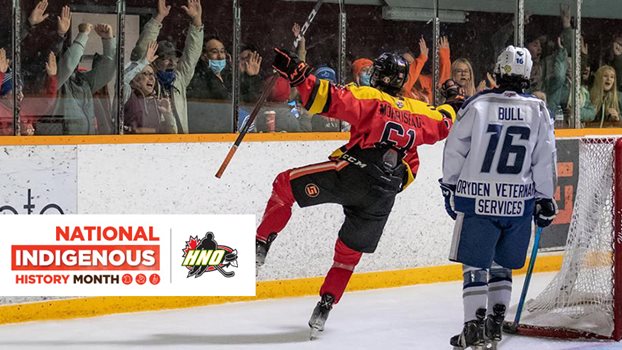
Fighting Walleye celebrate Indigenous culture
The Kam River Fighting Walleye hosted their first-ever Orange Wave Night to celebrate Indigenous culture and raise money for post-secondary scholarships
Trenton Morriseau says games like the Orange Wave Night are special, but he knows healing — and growth — when it comes Indigenous relations in Canada is a process.
Morrisseau’s junior hockey team — the Kam River Fighting Walleye of the Superior International Junior Hockey League (SIJHL) — hosted the inaugural Orange Wave Night on March 12 at Norwest Arena in Oliver Paipoonge, Ont., which celebrated Indigenous culture and traditions.
Members of the Fighting Walleye wore one-time orange design jerseys, sponsored by Jason Thompson and his company, Warrior Supplies and Engineering. The colour orange has become a symbol of the Indigenous movement. According to the team, the mission is to “celebrate diversity, promote cultural awareness and support the Indigenous community through sport.”
The game-worn jerseys were auctioned off and the money raised – more than $10,000 – went towards post-secondary scholarships for graduating Indigenous players.
Nineteen-year-old Morriseau, who was born and raised in Fort William First Nation, says the hard work by everyone in the Walleye organization and the sponsors to put this event together will go a long way.
“It’s really important to celebrate our culture with our community of Oliver Paipoonge,” he says. “You know, it’s just the step in the right direction for reconciliation and healing for Aboriginal people.”
While Morriseau is in his second year with the Walleye, a franchise started in 2020, this campaign was his first full one with the club after a large part of the 2020-21 season was cancelled due to the COVID-19 pandemic.
Morriseau is a graduate of the Thunder Bay Kings AAA program who finished the 2021-22 season ninth in SIJHL scoring with 21 goals and 29 assists.
He admits he would be lying if he didn’t encounter prejudice while moving up the hockey ladder.
“At some point, every Indigenous person is going to experience some kind of racism,” says the 5-foot-10 forward. “It’s our job to try and educate people and you know, tell them like what’s right. And it’s not their fault, what they hear at home from their parents and stuff either, right? So lots of times, they’re just good kids, and they’re just kind of repeating what they hear at home. You know what I mean? So it’s just it’s our job to educate them. We just have to keep that in mind.”
The opening ceremony of Orange Wave Night included an Indigenous drum group featuring Ron Kanutski, the Fort William First Nations Little NHL Team and special dignitaries within the community.
Dignitaries consisted of Aaron Kakapetum (senior commercial account manager of Indigenous banking, RBC); Trevor Iserhoff (director of inclusion and diversity, SIJHL); Colin Campbell (co-owner, Kam River Fighting Walleye); Jason Thompson (owner and founder, Warrior Supplies and Engineering); Chief Peter Collins (Fort William First Nation); Grand Chief Derek Fox (Nishnawbe First Nation); and Beatrice Hynnes (Ojibway anthem singer).
The Fighting Walleye capped off the celebratory evening with a win, coming from behind to down the visiting Dryden Ice Dogs 3-2 thanks to a game-winner from Morriseau with just 3:45 left.
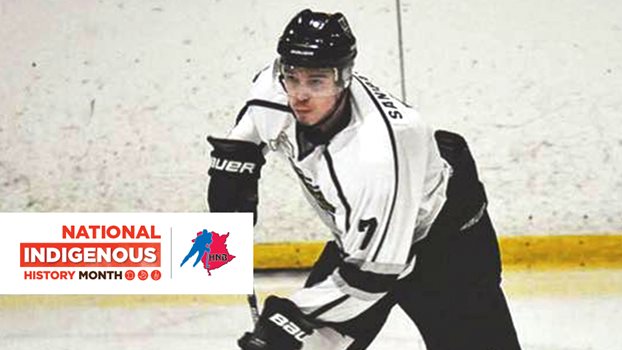
An opportunity to represent
Through the Aboriginal Apprentice Coach Program, Creighton Sanipass has a chance to coach at the 2023 Canada Games and serve as a role model for young Indigenous athletes
As a hockey player, Creighton Sanipass often noticed a lack of Indigenous representation in the game. As a coach, he hopes to do something about it.
Through the Aboriginal Apprentice Coach Program, Sanipass is part of the New Brunswick coaching staff for the 2023 Canada Winter Games.
He wants to serve as a role model for young Indigenous athletes who may have had similar experiences with underrepresentation.
“I hope that Indigenous athletes see that there are opportunities to get involved and help the future generation of athletes get the chances that they rightfully deserve,” says Sanipass. “I am proud to be Mi’kmaq. Our culture has a history with the sport and it’s not just by chance that Indigenous hockey players feel so comfortable on the ice – it’s in our blood.”
Sanipass learned to skate at the age of two and began playing minor hockey at four. His father, Everett, played 164 NHL games during a six-year pro career and represented Canada at the 1987 IIHF World Junior Championship, so hockey was always a part of his life. The 6-foot-2 forward played in the Maritime Hockey League (MHL) with the Valley Wildcats and St. Stephen County Aces and in the New Brunswick Junior Hockey League (NBJHL) for the Tri-County River Cats, finishing with 21 points in 21 games in his final season.
Now, learning a different side of the game as a coach, he’s honoured to be participating in the program and wants others to do the same.
“I hope that more Indigenous coaches become involved and become a face for Indigenous hockey players to look up to and strive to be,” he says.
In addition to his role on New Brunswick’s U16 team, Sanipass was also part of the coaching staff with Team Atlantic at the National Aboriginal Hockey Championships in Nova Scotia in May.
Off the ice, Sanipass is a university student majoring in criminology and works for Aboriginal Sport and Recreation New Brunswick.
“I’ve always wanted to have a job where I could help give opportunities to Indigenous youth that weren’t around when we were young,” he says. “Seeing Indigenous youth thrive makes it all worthwhile.”
It will be his first time attending the Canada Games, and he is excited to experience all the event has to offer, including the mentorship he’s receiving from more established coaches.
The Aboriginal Apprentice Coach Program provides up to two coaches per Canada Games from each province and territory the opportunity to develop their coaching skills. The program’s objectives include building coaching capacity within Aboriginal communities and providing coaches with professional development and learning opportunities for high-level coaching.
Sanipass will continue to absorb all he can on the road to Games, which are scheduled for Feb. 18 to March 5 across P.E.I., and beyond. He credits the sport with teaching him invaluable life skills and hopes he can pass that wisdom on to future players.
“I want to be an example. You can take everything that you have learned through your experiences and give back to the next generation. Up-and-coming athletes deserve the opportunities that might not have been around when we were younger, and we can be the reason that they are able to fulfill their potential.”
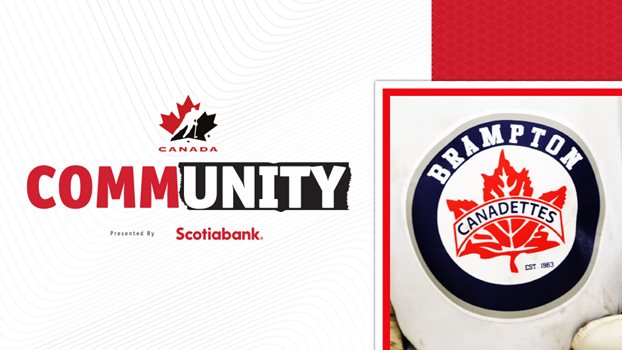
Community comes together for Canadette
When Amy St. John was seriously injured in a tragic accident last December, her hockey family rallied to support her mother and four siblings
When tragedy struck one of their own, the hockey community in Brampton came together.
Last December, Amy St. John, a 12-year-old goaltender for the U15 Brampton Canadettes, was seriously injured when she was struck and dragged by a school bus on her way to school.
Paramedics rushed her to Toronto Sick Kids Hospital, but she was transferred to St. Mike’s Hospital due to the extent of her injuries. Amy suffered a crushing injury to the back of her pelvis and significant nerve damage to her left leg, and needed reconstructive surgery.
When Tina Kelloway, vice-president of the Brampton Canadettes Girls Hockey Association (BCGHA), heard about Amy’s accident, she reached out to Amy’s mom, Joelle, right away to see how the association could support the St. John family.
“I was absolutely heartbroken and just thinking about it still makes me want to cry,” Kelloway says. “I’ve known Amy for years as she came up through our house league divisions and hockey was always a joy for her – she adored playing and she always has a smile on her face when she came to the rink.
“I can’t begin to imagine the trauma Amy was going through and what her family had to go through with her. It was such a horrendous event.”
Amy is the youngest of five children. With the accident, Joelle has been unable to work in order to care for her daughter.
With the significant financial strain to the family, as well as the extent of physiotherapy and care that Amy needed right after the accident and into the future, the Canadettes quickly came together to figure out a way to help.
“Another mom and I started the fundraising page, but asked the league to step in to help build awareness,” says Jill Hartling, the Canadettes team manager. “The girls were shocked and devastated for what happened to Amy and the team just wanted to jump on board and help her.”
Over the Christmas period, the team put together a gift basket with beauty products and arts and craft materials for Amy to help life her spirits.
“Amy was home at the time when we dropped that basket off and it was nice to talk with her and see how she was doing,” says Hartling. “The team rallied around the St. John family and they were always thinking of Amy this season.”
The league previously held a fundraiser in 2018 for another player who needed help after an accident and used that experience to build awareness for Amy and her family. Every spring, the BCGHA holds its annual Easter Tournament, which is one of the largest girls’ hockey tournaments in the world. This year, it included 380 teams.
Through that tournament, the Canadettes held a silent auction with various pieces of sports memorabilia, and shared Amy’s story to create awareness for donations.
“The majority of teams that participated in the tournament provided a donation or silent auction bids,” says Kelloway. “The vast support we and Amy received from the community was nice to see. We raised a lot of money for Amy’s recovery through the silent auction and donations.”
Donations came in from players, teams and anonymous donors across the Greater Toronto Area. Throughout the past few months, the league and the family has felt the power of the hockey community.
“This has shown just how amazing the hockey world is. The hockey community is incredible … how everyone comes together to rally to help others,” Kelloway says. “It is overwhelming how generous teams, players and families have been. You can see through the donations how supportive and encouraging everyone has been towards someone they may have never interacted with before. The generosity everyone has shown is incredible. After the last couple of years with the pandemic, this story shows the positive and caring side of community and that’s refreshing.”
While Amy has shown strength and determination in her recovery, her prognosis is still unknown. Kelloway and the BCGHA are hoping the funds raised will help the family in any way they need it.
In a written statement, Joelle shared how much everything has meant to her and the family: “As a mother going through one the hardest times, I am overwhelmed by the love and support of the Canadettes and how without hesitation, they rallied around my kids and I. When you have a child recovering from this type of accident, everything changes, and your child’s recovery must take priority. I am overwhelmed with gratitude.”
The fundraiser for Amy St. John is still ongoing and will remain open to donations.

Helping in a time of need
When a historic weather event caused devastating flooding and landslides in British Columbia, the hockey community came together to help affected residents and teams
The hockey community is unlike any other. In times of need, hockey families across the country have proved time and time again that they are ready and willing to help their communities.
When record-breaking rainfall hit southwestern British Columbia in November, several local hockey associations came together to support communities that were impacted by devastating flooding and landslides. Here are a few ways these associations and teams worked to help.
Summerland Minor Hockey Association
The Princeton Posse may be a long-time rival of the Summerland Jets, but that rivalry was set aside to put community first after the destructive flooding. When Summerland’s U9 team hosted the Posse, players, parents and staff organized a food drive to send some essential items back with the Posse’s families. Along with the food drive, the team made goody bags for each Princeton player that included packs of Pokemon and hockey cards.
Check out this article on the great work done by the Summerland U9 minor hockey team to help out their rivals from Princeton during these tough times 👏👏 https://t.co/JZ1Fbk323r
— BC Hockey (@BCHockey_Source) November 24, 2021
Greater Vernon Minor Hockey Association
After hosting the Merritt Centennials, the Vernon Junior Vipers’ U11 Development C team invited its opponents for a pizza dinner in a dressing room. Players from the Vipers helped to set up the dressing room before the game, hoping the small gesture would make the Centennials feel supported by other communities in B.C.
There was another act of kindness by the association when the Abbotsford Hawks, who were supposed to travel to Vernon for a tournament, had to cancel their travel plans due to the flooding. According to the GVMHA’s Facebook page, participants and spectators at the tournament worked together to raise $1,000 for the Hawks ahead of the holiday season.
Penticton Vees — British Columbia Hockey League
Following a weekend win in Trail, B.C., the BCHL’s Victoria Grizzlies travelled to Penticton for what was originally planned to be an overnight stay. However, with the historic storm, the team was stuck and unable to travel home.
With the unexpected extended stay, the Penticton Vees stepped up and gave the Grizzlies a dressing room and ice to practice on while they were in town.
"When the puck drops, we want to beat the other team, but we're partners and we wanted to make sure we made their stay as comfortable as possible," Vees president, head coach and general manager Fred Harbinson told CTV News.
The boys are headed home following a very extended weekend on the road due to highway conditions. Thank you @cityofpenticton for everything, the citizens, the @PentictonVees, @pentictonresort and all the local area businesses.#Community #Okanagan pic.twitter.com/crTsC6vhd7
— Victoria Grizzlies (@BCHLGrizzlies) November 17, 2021
Squamish Minor Hockey Association
After the Squamish Eagles U13 A2 team had a game against Chilliwack cancelled due to the storm, the players decided to run a food drive instead. The team gathered outside a local grocery store to encourage shoppers to help fill a hockey net with food to support the Fraser Valley flood victims.
With support from the Cloverdale Community Kitchen for distribution, the Eagles raised $530 and gathered several boxes of food for those affected in Chilliwack.
Squamish hockey team supports flood victims in Chilliwack https://t.co/a0IrZRLHhl
— Surrey Now-Leader (@SurreyNowLeader) November 29, 2021
Mission Minor Hockey Association
When the Mission Stars heard about the historic flooding, the association organized a “Fill the Trailer“ event. From non-perishable food items to things like blankets, winter jackets, socks and toiletries, the Stars ran the event for four hours at a community centre all to give back to communities affected by the storms.
Mission hockey trying to Fill The Trailer https://t.co/qYwSiejQ9U
— Mission City Record (@MissionRecord) November 27, 2021
Ridge Meadows Minor Hockey Association
The Ridge Meadows Minor Hockey U18 C1 team was preparing for a hockey tournament in Abbotsford when the flooding occurred. When the team saw the devastating impact in Abbotsford, it decided to donate $300 to the Abbotsford Disaster Relief Fund to support Abbotsford hockey families and others affected by the flooding.
We are SUPER proud of our U18 C1 team for presenting a certificate of donation, to the Abbotsford Flood Relief Fund, to their @abbotsfordminor opponents during their last game. We are one #hockeyfamily #rustlerpride #rustlerrespect You can donate here: https://t.co/OGXpN2TNpF pic.twitter.com/Eu5ZbSJ2zj
— Ridge Meadows Hockey (@RustlersHockey) November 29, 2021
Cloverdale Minor Hockey Association
The Cloverdale Minor Hockey Association had previously planned a 50/50 draw for its U21 team in December. After the destructive storms in November, the association also wanted to use its fundraiser to support the flood relief efforts. Cloverdale announced that 25 per cent of the proceeds from its 50/50 draw would support victims of the flooding.
Our U21 50/50 has gone ONLINE! Prize will be drawn on Dec 22nd @ 6PM While our tournaments are important fundraisers for our Association, we also want to help the victims of the recent floods. So - 25% of the proceeds will be donated to flood relief! … https://t.co/0y1PmRjsc3 pic.twitter.com/OT7OJi6GfB
— Cloverdale MHA (@CloverdaleMHA) December 10, 2021
North Delta Minor Hockey Association
The North Delta Minor Hockey Association decided to organize an association-wide bottle drive to support the residents of Merritt, B.C., who were evacuated due to flooding. The idea was created and spearheaded by Tam Manery, who was inspired to run the drive when her son’s tournament in Merritt was cancelled.
Although the weather could have been better during the bottle drive, parents and players helped with picking up and sorting bottles. The association says there was a steady stream of bottles and generous cash donations, which will all go towards a great cause.
^^^ Thanks everyone! pic.twitter.com/5I2FdehEt3
— North Delta Hockey (@ndminorhockey) November 29, 2021
Thank you to these hockey teams, and to everyone who stepped up to help their surrounding communities in a time of need. Your positive impacts in your communities have inspired us all to make a difference.

Rallying in lavender
With sticks wrapped in lavender tape, players from Hockey Regina are leading the charge to raise money for the Canadian Cancer Society through Hockey Fights Cancer
Certain colours can hold special meanings and unite communities. For example, when Canadians think of red, we think about the pride of representing the Maple Leaf.
In Regina, Sask., the colour lavender is the talk of the town. That’s because Hockey Regina is running its Lavender Days campaign in association with the Canadian Cancer Society.
“Cancer touches so many, and it’s important to me to have the players remember that there’s bigger stuff than them,” says Joanne Eberle, the media and events manager with Hockey Regina. “The kids really take ownership of it.”
Now in its third year, about 170 teams in Regina participate in the fundraising drive to support Hockey Fights Cancer through November and December. Lavender tape is put on sticks, decals are placed on helmets and the two AAA teams in town wear lavender jerseys that are later auctioned off for the campaign. From Timbits U7 to U18, the players on each team decide how they want to raise money and give back to their community.
“They were pieing their coach, they were doing candy guess jars, they were doing all kinds of stuff,” Eberle says. “We have some teams that will shovel snow, they’ll donate their allowance, or they’ll do a read-a-thon or a walk-a-thon or exercise in some way. We really left it open to all the teams.”
Eight-year-old Aliya Hartney had her own creative idea to help raise money for Lavender Days.
“I did a video and I talked about cancer and why we help people because you want to help people to not lose their loved ones from cancer,” she says.
That sentiment hits close to home for Hartney as her grandmother died from brain cancer when her mother was only four years old. Her video helped to raise $1,505 for Lavender Days.
“I like helping people,” she says. “The more money we raise, the closer we can get to find a cure for cancer.”
The campaign takes on a deeper meaning when people in the hockey community have personal connections to cancer. Following the conclusion of a previous Lavender Days campaign, a player received a cancer diagnosis. Their team responded by bringing back lavender tape for their sticks to show support.
“It’s something that doesn’t just stick with them for the two months that we do it,” Eberle says. “It’s something that they carry through the whole season.”
For the special AAA Lavender Games, each home team chose someone associated with the team that had a cancer story for a ceremonial puck drop. The Regina Pat Canadians chose a 12-year-old hockey player who was battling cancer. The Regina Rebels chose their trainer’s two-year-old nephew, who was also fighting cancer.
“If there was a dry eye in that house, I’d be surprised,” Eberle says. “It was such a big impact, having this little guy come out there and drop the puck and knowing why he was there.”
Daren Haygarth has been a hockey coach for close to 20 years. The support for Lavender Days in his community has had a profound effect on him based on his family’s connection to cancer.
“My sister-in-law has gone through nine surgeries related to a breast cancer diagnosis and gone through chemo,” he says. “When my son tapes up his sticks and writes her name on them, all of those things tug at my heartstrings a lot.”
Last May, Haygarth began his own personal cancer journey. He was diagnosed with prostate cancer and underwent successful surgery in July 2020. Haygarth initially kept his diagnosis private, but over time he began to tell his friends in the hockey community.
“Of course, my family was super supportive, but you start to realize how supportive the hockey world is,” he says. “The support was just overwhelming.”
Haygarth is now cancer free, but the support he received from his community after his experience reinforced how many positives come from a fundraising campaign like Lavender Days.
“There’s no such thing as a tough time where other people won’t be there to help you through it. I think that’s what I’ve really come to appreciate about Lavender Days and the fundraising efforts that go with it. It’s just raising that kind of awareness that things are bigger than ourselves.”
His U13 AA team, the Regina Royals, is running 50/50 draws this month to support Lavender Days.
“I wasn’t surprised [when] one of our parents won the 50/50 and they just donated it all back,” he says. “Our goal is to raise over $1,000 this month, and we’re way beyond probably going to meet that goal.”
Huge congrats to our players on becoming the recipients of a philanthropic award in the Outstanding Youth Philanthropist category! This is for their amazing contributions to Hockey Fights Cancer Thanks Katelyn for accepting on behalf of our players.#hockeyreginafightscancer https://t.co/QVg8VUUudP
— Hockey Regina (@HockeyRegina) November 5, 2021
Although Hockey Regina couldn’t do as much fundraising last year due to the COVID-19 pandemic, it has managed to raise over $26,000 in the past two years. Earlier this month, Hockey Regina’s youth players were the recipients of a philanthropic award for Outstanding Youth Philanthropist for their efforts with Lavender Days.
“That’s really exciting for them,” Eberle says. “It’s a youth award, so it doesn’t have anything to do with the adults… it’s about the players and what they’ve done as a whole.
“This is a great way to show kids that your little efforts can turn into something big.”
The goal this year is to raise over $20,000 for Hockey Fights Cancer. Haygarth credits Eberle for leading the creation of positive social interaction between teams while raising money for a good cause.
“It takes somebody within the organization to spearhead these things and create that culture shift,” he says. “I think Joanne’s been a big catalyst here in Regina towards thinking a little differently about hockey and what being a hockey player means.”
For Eberle, the fact the entire community is rallying around a unified cause while decked out in lavender warms her heart.
“Being able to do this as a minor hockey association as a whole is really exciting,” she says. “It unites everybody. Hockey is competitive, but they [put] that aside and turn into one big team. I absolutely love that.”
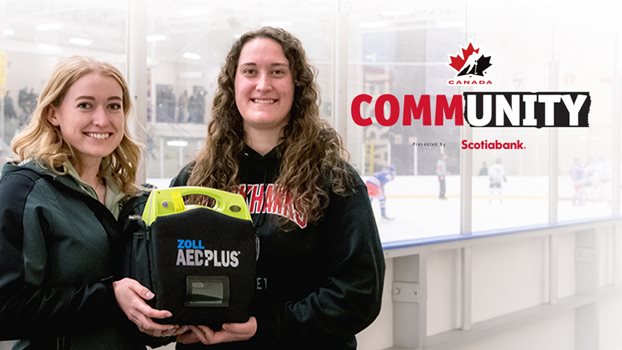
Coming together to save a life
Three Calgary Buffalo Hockey Association trainers were in the right place at the right time, and their quick-thinking – and a powerful community response – saved a player’s life
Sometimes, decisions are made in life that are meant to be. Just like how the little voice in trainer Haley Patyna’s head told her not to forget her medical bag as she went to Cardel Rec South in Calgary on Oct. 7.
Or how trainers Shyin Dixon and Blair Olsen weren’t originally supposed to be at the rink that night, but they joined Patyna to assist her U21 team with baseline concussion testing.
“Looking back, it was kind of wild because it was supposed to be just me,” says Patyna, 24. “But luckily, it was all three of us.”
Ultimately those two decisions are a part of the reason why a life was saved that evening.
As the clock ticked past 10 p.m., only Patyna’s U21 team and a 55-plus recreational league remained at the rink. With their testing complete, the Calgary Buffalo Hockey Association trainers were socializing and catching up in the hallway.
“These two guys came out of the rink where [the recreational league was playing], and they said that they needed an AED [automated external defibrillator],” says Olsen, 23. “They said they had a guy on the ice that was having a heart attack.”
The three trainers sprung into action. Olsen went to grab the AED located at the arena while Patyna grabbed her medical bag. Patyna and Dixon were first on the ice to assist the player.
“He was very obviously in medical distress, really struggling to breathe,” says Dixon, 24.
With the AED in hand, Olsen joined her fellow trainers on the ice, and they began to set up the defibrillator on the player. Dixon began CPR when they noticed the man had stopped breathing and they couldn’t find a pulse.
The trainers’ interventions with the AED worked, and within a few minutes the man was fully conscious and speaking again.
“It wasn’t long at all, granted when we were out there it felt like eternity,” Patyna says. “It was maybe five minutes before he was fully aware, he knew where he was and he knew what had happened.”
As a part of their preparedness for every game, trainers have an action plan to assign who will do what role in an emergency. But the three trainers were not the only ones who played a key role in this situation. The recreational league team on the ice was actively helping in any way it could, from taking off the player’s equipment, calling 911 and providing towels and blankets.
“Even before the paramedics showed up, the team was donating all of their jerseys to help keep him warm on the ice,” Dixon says. “The team was a fantastic help during that, they were there for anything that we needed.”
“I hope those guys give themselves credit for it, too,” Olsen says. “They were quick to give us credit for it, but their effort was just as important.”
Team work makes a dream work or saves a life! All in a days work. So proud of these CBHA trainers. pic.twitter.com/N1T8QCOjUY
— Pam Vega (@PamBradRuby) October 9, 2021
As the paramedics arrived and loaded the player onto the stretcher, he was chatting and joking with his teammates.
“It was definitely a relief to see him going off to the hospital in high spirits and in a good mood,” Patyna says.
Since the night of the emergency, the community reaction Dixon, Patyna and Olsen have experienced for saving a man’s life has been surreal.
“I did not expect it to blow up as much as it did,” Olsen says. “When we left the rink, we just were happy that it had a happy outcome.”
“To all of us, we just did what we were trained to do,” Patyna adds. “We don’t do it to expect a reward out of it. We do it because we love it.”
The incident has also re-confirmed the importance of having AEDs located in public areas.
“They’re very straightforward to use. They come with very detailed instructions,” Dixon says. “Even if it saves one life, it’s 100 per cent worth it every single time.”
“My dad was talking about getting one installed in their office after the whole situation,” Olsen adds.
This past weekend, the player returned to the rink to look for the trainers who saved his life. Olsen and Patyna were there, and they got to speak with him and his family in person to see how he was doing since the emergency.
“That was really nice,” Olsen says. “It was good to see him in as good of a condition as he’s in now.”
Looking back, two things stand out to the trainers: how important it is to always be prepared and how powerful a community response can be in emergencies.
“That was really a team effort that night from everyone,” Olsen says. “If I were to ever go through this again, I would just remember that the people around me are my team, use them.”
“I was amazed at the sense of community that night,” Dixon adds. “It’s insane how people just come together to help one person.”
For more information: |
- <
- >
















